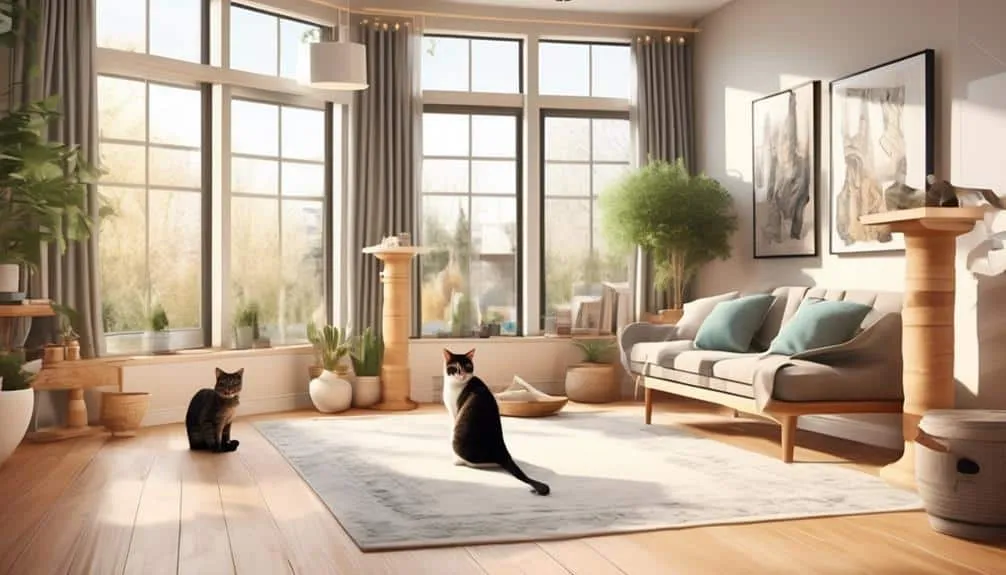The Best Fluffy Pancakes recipe you will fall in love with. Full of tips and tricks to help you make the best pancakes.

Coincidentally, have you ever wondered where the best spot is to place your cat tree?
Well, today we're going to unravel the mystery and reveal how it can enhance the social significance and behavior of your furry companion.
Whether you're a new cat owner or a seasoned pro, understanding the optimal placement for cat trees is crucial in creating an environment that fosters positive interactions and provides a sense of security for your feline friend.
So, get ready to discover the secrets behind strategically positioning your cat tree and creating a haven that will leave your cat purring with delight.
Key Takeaways
- Placing the cat tree in a socially significant area, like the living room, allows cats to feel like part of the family and be aware of what's going on.
- Observing your cat's preferred locations can help determine the best room for the cat tree, ensuring it is placed in an area where the cat already enjoys spending time.
- Cat trees can be used to redirect unwanted behaviors, such as scratching, by providing a better alternative in a socially significant area.
- Careful placement of the cat tree can help avoid conflicts with other pets, ensuring it is not near high-value resources and considering the dynamics between pets.
Importance of Social Significance
Placing the cat tree in a socially significant area, such as the living room, allows cats to feel like valued members of the family and satisfies their natural need for social interaction. Cats are social creatures, and being a part of the family's activities in the main living space provides them with social benefits.
This placement also allows cats to claim territory and establish their presence in the household. Cats have a natural inclination to mark their territory, and having the cat tree in a socially significant area provides them with prime real estate for scratching and claiming their space. By redirecting their scratching behavior to the cat tree, cats can protect furniture and satisfy their territorial instincts.
Placing the cat tree in a socially significant area promotes social interaction and territorial behavior, enhancing the overall well-being of cats in the family dynamic.
Observing Preferred Locations
To better understand the ideal location for your cat tree, it's important to observe and take note of your cat's preferred spots within your home. Here are three key considerations when observing preferred locations:
- Considering cat's comfort: Pay attention to where your cat likes to relax and nap. Cats have favorite spots where they feel at ease and secure. Placing the cat tree in a similar area can provide a sense of familiarity and comfort for your cat.
- Utilizing existing spaces: Take note of the rooms or areas where your cat spends the most time. Cats appreciate having their own space in areas they already enjoy. By placing the cat tree in a room where your cat already frequents, you can maximize its usage and ensure it becomes a central part of your cat's daily routine.
- Considering your cat's habits: Observe your cat's movement patterns and preferred activities. Cats may have specific routes they take around the house or certain areas where they like to play. By placing the cat tree along these routes or near their favorite activities, you can increase the likelihood of your cat utilizing the tree and engaging with it regularly.
Addressing Behaviors With Cat Trees
Cat trees can be an effective tool for addressing unwanted behaviors in cats. Redirecting unwanted behaviors is essential for maintaining a harmonious household. Placing the cat tree near areas where these behaviors occur can provide a better alternative.
For example, if your cat tends to scratch furniture, placing the cat tree nearby can redirect their scratching behavior to the tree instead. Additionally, cat trees can provide mental stimulation and enrichment, which can help reduce unwanted behaviors.
Cats have a natural need for elevated perches, and having a cat tree that fulfills this need can prevent them from seeking out higher spaces like countertops or shelves. By redirecting unwanted behaviors and providing mental stimulation, cat trees can significantly contribute to a well-behaved and satisfied cat.
Avoiding Conflict With Other Pets
When considering the placement of your cat tree, it's important to take into account the dynamics between your pets to avoid potential conflicts.
To ensure a harmonious environment for all your pets, follow these guidelines:
- Avoiding territorial conflicts: Cats are naturally territorial creatures, and conflicts can arise when they feel their space is being invaded. By creating a separate space for each pet, you can minimize territorial disputes and promote a peaceful coexistence.
- Providing alternative locations: To avoid creating conflict, it's essential to provide alternative locations for other pets. By offering separate spaces, such as additional cat trees or designated areas, you can ensure that each pet has their own territory and reduce the likelihood of resource guarding or aggression.
- Considering the dynamics between pets: Each pet has their own personality and preferences. When placing the cat tree, consider the dynamics between your pets and ensure that it's positioned in a neutral area. This will help prevent conflicts and allow each pet to have their own space without feeling threatened.
Stability of the Location
Placing the cat tree in a stable location is crucial to ensure the safety and security of your cat. Choosing stable cat trees is important, especially if you have larger cats like Maine Coons that require more stability.
One option is to place the cat tree firmly in a corner, which can help stabilize it. Another option is to consider wall mountable cat trees that come with stabilizers that can be mounted into the wall. These wall mountable cat trees provide an extra level of stability and can give you peace of mind knowing that your cat is secure while using the tree.
Best Locations for Cat Trees
To ensure the stability and security of your cat tree, it's crucial to select the best locations that provide both physical support and meet the social needs of your feline friend.
Here are three key considerations for placing your cat tree:
- Incorporating cat trees into home decor:
Choose a location that blends well with your home's aesthetic. Opt for a cat tree that complements the existing furniture and decor, ensuring it becomes a seamless part of your living space.
- Maximizing vertical space for cats:
Cats love to climb and perch in high places. Place the cat tree near a window or in a corner where it can provide vertical space for your cat to explore and observe their surroundings.
- Socially significant areas:
Cats are social creatures and want to be where the action is. Select a room where your family spends the most time, such as the living room or dining room. This allows your cat to feel included in daily activities and interact with family members.
Worst Locations for Cat Trees
The placement of cat trees in certain locations can be detrimental to the well-being and comfort of your feline companion. When considering the worst locations for cat trees, two important factors to keep in mind are noise considerations and space constraints.
Cats are sensitive to loud noises, which can cause stress and anxiety. Placing the cat tree in areas with high noise levels, such as laundry rooms or near appliances, can be distressing for your cat.
Additionally, space constraints can limit the cat's ability to fully enjoy the tree. Cramped areas like garages or small closets may restrict movement and hinder the cat's exploration and play.
It's crucial to choose a location that provides a quiet and spacious environment for your cat's well-being.
Choosing the Right Location
Considering the well-being and comfort of your feline companion, it's important to carefully select the optimal location for your cat tree, taking into account factors such as noise levels and available space.
Here are three tips for choosing the right location for your cat tree:
- Find a socially significant area: Cats are social creatures and prefer to be where the action is. Placing the cat tree in a room where you spend the most time, like the living room, allows your cat to feel like a part of the family and mingle with you.
- Observe your cat's preferred locations: Take note of where your cat likes to hang out and place the cat tree in the same room or nearby. Cats appreciate having their own space in areas they already enjoy.
- Address unwanted behaviors: If your cat has certain areas where unwanted behaviors occur, like scratching furniture, place the cat tree near those areas. This provides a better alternative and helps redirect their behavior.
Frequently Asked Questions
How Can I Train My Cat to Use the Cat Tree?
To train your cat to use the cat tree, use positive reinforcement and rewards. Encourage them to explore and climb by placing treats or toys on the tree. Consider cat tree alternatives like scratching posts to redirect their behavior.
Can I Place the Cat Tree in a Small Room if I Don't Have Space in a Socially Significant Area?
In small rooms, maximizing vertical space for cat trees can create a cat-friendly environment. However, placing the cat tree in a socially significant area has benefits like promoting social interaction and behavior.
Should I Place the Cat Tree Near a Window?
Placing the cat tree near a window has benefits. Cats enjoy watching outdoor activities, which provides mental stimulation. To make the cat tree more appealing, consider adding cozy bedding, toys, and scratching surfaces.
Can I Place the Cat Tree in a Room Where My Dog Also Spends a Lot of Time?
Yes, you can place the cat tree in a room where your dog spends a lot of time. This can promote positive dog-cat interaction and enhance the benefits of cohabitation between the two animals.
What Are Some Signs That My Cat Is Not Comfortable With the Location of the Cat Tree?
If your cat is not comfortable with the cat tree's location, they may avoid it, show signs of stress, or exhibit unwanted behaviors. Training cats to use cat trees involves finding a suitable location that meets their needs and preferences.
Conclusion
In conclusion, strategically placing a cat tree in socially significant areas of your home can greatly enhance the bond between you and your feline companion.
Not only does it provide them with a space to mingle with you and feel like a part of the family, but it also helps address behavioral issues and provide mental stimulation.
Interestingly, a study conducted by researchers found that cats who'd access to a cat tree in a socially significant location showed a 30% decrease in territorial marking behaviors.
This highlights the importance of providing the right environment for our furry friends.










